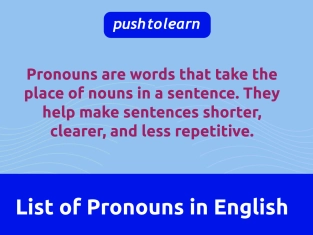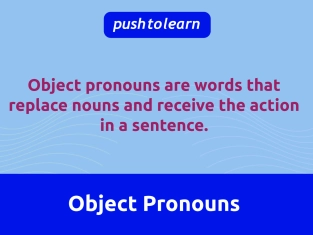by PushtoLearn
Possessive Pronouns
Table of Contents
Possessive Pronouns - Exercises
These exercises focus on Possessive pronouns
Possessive Pronouns Table
|
Pronoun |
Used For |
Example |
|
Mine |
First person singular |
"This book is mine." |
|
Yours |
Second person singular |
"Is this pen yours?" |
|
His |
Third person singular (male) |
"The phone is his." |
|
Hers |
Third person singular (female) |
"The jacket is hers." |
|
Its |
Third person singular (neuter) |
"The dog found its bone." |
|
Ours |
First person plural |
"This garden is ours." |
|
Yours |
Second person plural |
"These seats are yours." |
|
Theirs |
Third person plural |
"The bikes are theirs." |

Tips for Usage
-
Use Possessive Pronouns to Replace Nouns
When it’s clear what object or person you’re talking about, you can use a possessive pronoun to avoid repeating the noun.
Example:
Instead of “This is John’s phone,” say, “This is his phone.”
-
Possessive Pronouns Do Not Use Apostrophes
Unlike possessive nouns (e.g., “John’s book”), possessive pronouns do not use apostrophes.
Correct: “The car is hers.”
Incorrect: “The car is her’s.” -
Possessive Pronouns Agree with the Subject
Choose the correct possessive pronoun to match the subject in number (singular or plural) and gender (male, female, or neutral).
Example: -
“These are their keys,” for plural subjects.
-
“This is her notebook,” for a female subject.
Common Mistakes
-
Confusing “Its” and “It’s”
Its shows possession, while it’s is a contraction for “it is.” -
Correct: “The cat licked its paw.”
-
Incorrect: “The cat licked it’s paw.”
-
Using Possessive Adjectives Instead of Possessive Pronouns
Possessive pronouns (mine, yours, his, hers, ours, theirs) replace a noun. Possessive adjectives (my, your, his, her, our, their) describe a noun. -
Correct: “This book is mine.”
-
Incorrect: “This book is my.”
-
Forgetting Agreement in Number and Gender
Remember to choose a pronoun that agrees with the subject’s number (singular/plural) and gender. -
Correct: “The toys are theirs.”
-
Incorrect: “The toys are his” (if they belong to multiple people).
FAQ
What is the difference between “its” and “it’s”?
Its is a possessive pronoun meaning “belonging to it,” while it’s is a contraction for “it is” or “it has.” For example, “The dog wagged its tail” (possessive), and “It’s a nice day” (contraction for “it is”).
See also Its vs It's
Can “yours” be used for both singular and plural?
Yes, yours can refer to both one person and multiple people. For example, “Is this pen yours?” (singular) and “Are these seats yours?” (plural).
Why don’t possessive pronouns have apostrophes?
Possessive pronouns like “hers,” “theirs,” and “ours” are already in possessive form and don’t need an apostrophe. Adding one would be incorrect.
How do I know when to use “his,” “her,” or “their”?
Use his for male subjects, her for female subjects, and their for plural subjects or when the gender is unknown or neutral.
Is there a possessive pronoun for “it”?
Yes, its is the possessive pronoun for “it,” used for things, animals, or objects. For example, “The tree lost its leaves.”

